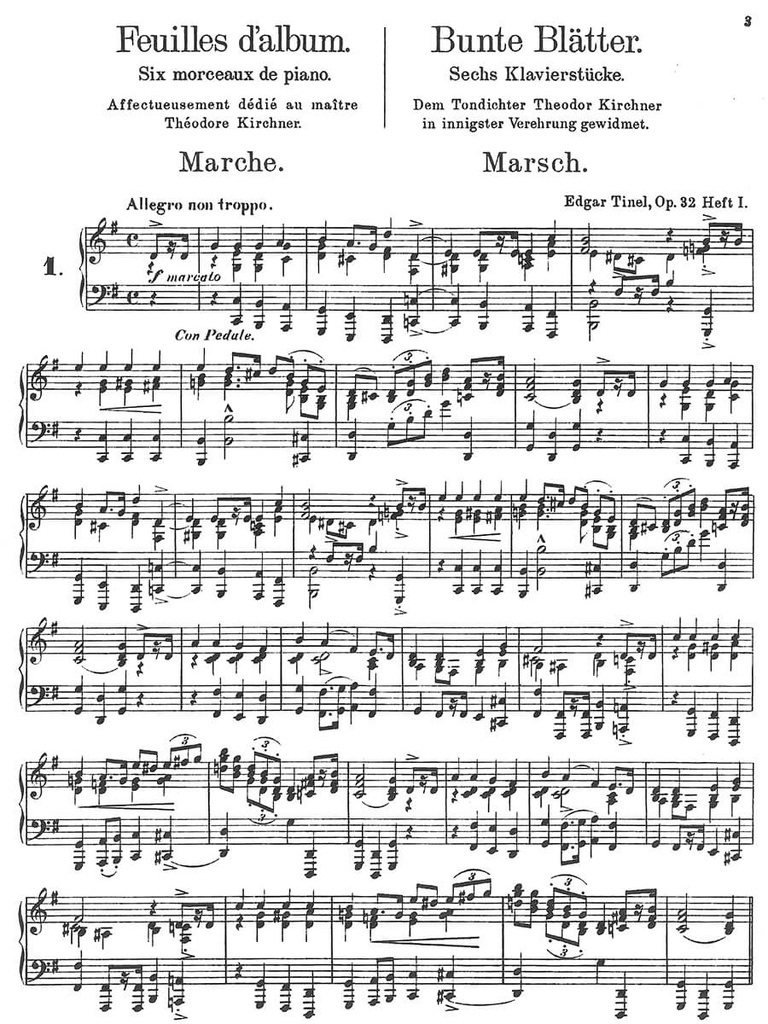Bunte blätter, Op.32
Description
Edgar Tinel
(Sinaai, 27 March 1854 – Brussels, 28 october 1912)
Bunte Blätter op. 32
(1885)
‘Je suis fou! J’ai fait la connaissance de Brahms, et Brahms m’a parlé!’ (‘I’m hysterical! I’ve become acquainted with Brahms, and Brahms talked to me!’) Thus an enthusiastic Edgar Tinel noted in his diary on 18 May 1883. Four days later he printed in a letter: ‘C’EST LE PLUS GRAND HOMME DU SIÈCLE’. Together with some Belgian colleagues he had attended the Niederreinische Musikfest, organized by Ferdinand Hiller, in Cologne from 13 through 16 May. For its sixtieth edition this prestigious Rhine Festival had singled out Brahms as its focus. On the second day the orchestra, with a strength of 130 musicians, among them many Belgians, accompanied Brahms as soloist in his second piano concerto, and on the final day he was acclaimed as conductor of his second symphony. For Tinel it was an unforgettable experience, with an impact comparable to that of a performance by Robert Schumann of his third sonata, when he was fourteen. The remembrance of both concerts was to stay with him for the rest of his life. Brahms and Schumann were Tinel’s shining examples. He dubbed them, together with Bach, ‘apostles of the Ideal’. Tinel was one of those composers at the end of the 19th century whose idiom had not been infected with the ‘Wagner virus’. Tinel recognized the genius of Wagner, but rejected his operas as amoral on the basis of his strict catholic principles. However, this did not prevent him from conducting certain fragments.
Like Schumann and Brahms Tinel started his career as a pianist-composer. At the conservatoire in Brussels he studied piano with Jean-Baptiste Michelot, Alphonse Mailly and the Wagnerian Louis Brassin. After graduating in 1873 he enjoyed a brief career as piano virtuoso, leading him to such cities as Aachen and London. Meanwhile he studied counterpoint and fugue with Hubert Ferdinand Kufferath (a pupil of Mendelssohn) and composition with director François-Auguste Gevaert.
As a composer Tinel first proved his mettle with songs and piano music. One of his early works is a powerful Sonata dedicated to Brassin. In February-March 1885 he composed the piano cycle Bunte Blätter, two volumes with three pieces each. This work had been commissioned by the German music publisher Breitkopf & Härtel, which from then on was to publish an important part of Tinel’s oeuvre as well as supporting the enormous international success of his musical hagiography Franciscus (1886). During the composition of Bunte Blätter Tinel became very ill. Once in a while he was even haunted by a foreshadowing of doom about the final Adagio as possibly his swan song. However, Tinel got well again, and even before leaving on a pilgrimage to Lourdes in the Marian month of May he was in a position to deliver the work to his publisher. Initially he considered dedicating his new composition to Brahms, but eventually he preferred Theodor Kirchner. This German organist-composer associated a lot with the circle around Schumann, while his organ playing was greatly admired by Liszt and Wagner. Tinel was most impressed by Kirchner’s piano compositions, praising him in a rather exalted way as ‘le plus profond poète du piano de tous les temps’ (‘the most profound poet of the piano of all times’). Later, when Kirchner was down and out because of his eccentric lifestyle, Tinel founded a support committee, raising funds for his unlucky colleague.
Bunte Blätter, a title in the mode of Schumann, is a kaleidoscopic suite in which each of the six pieces has a distinctive character of its own. The first volume starts with a vigorous March which sets off with energy and a clear rhythm to meet with the theme of the trio, a lovely melody, unfolding itself in trioles. After a gracious Scherzino a gentle and subtle Allegretto concludes the first book. The second volume opens with a gracious Menuet with allusions to Schumann, followed by a feverish Appassionato, eventually achieving closure with a sombre and elegiac Adagio in c minor, including an echo of the De profundis.
The Bunte Blätter were premiered on 31 August 1885 at the Muncipal Party Hall in Mechelen at a celebration of the tenth anniversary of the ‘Davidsfonds’, a catholic cultural organization. On the same programme featured Klokke Roeland, the cantata with which Tinel had earned the Prix de Rome in 1877.
Jan Dewilde
(Translation: Joris Duytschaever)
Reprint of a copy from the library of the Royal Flemish Conservatory in Antwerp. This score was published in cooperation with the Centre for Flemish Music (Studiecentrum voor Vlaamse Muziek, (www.svm.be).
